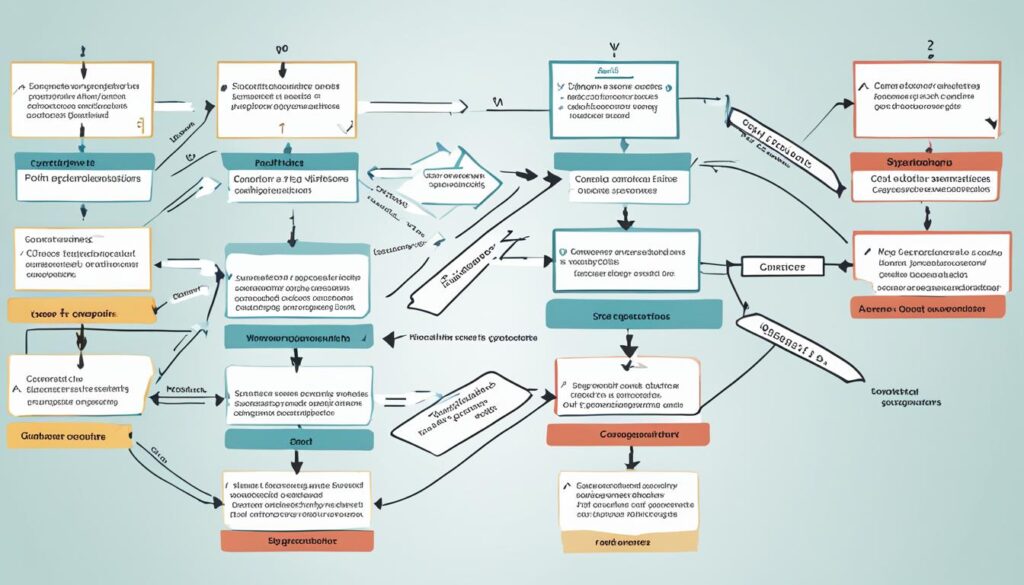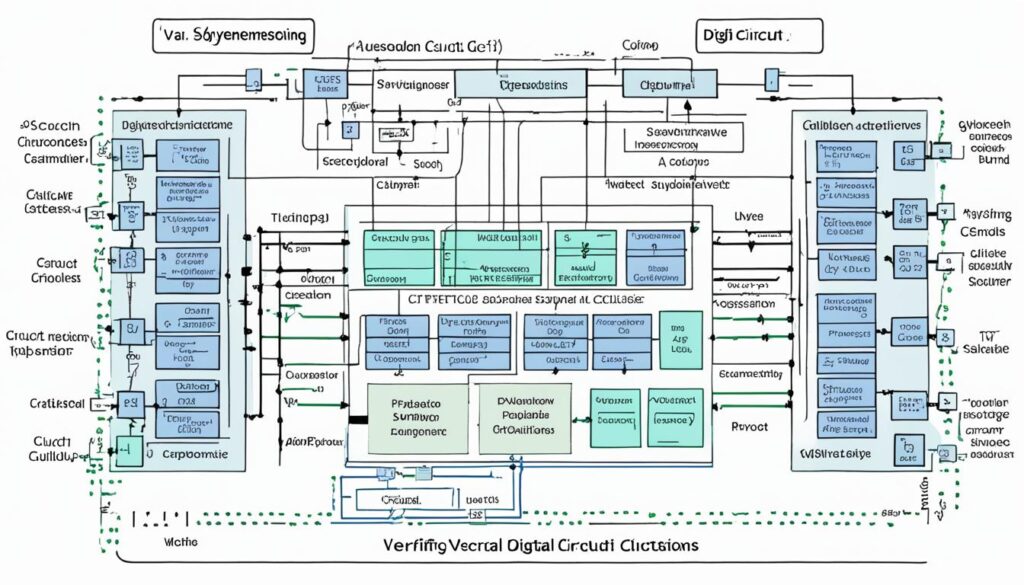Welcome to our comprehensive guide on SystemVerilog Assertions. In this article, we will delve into the world of SystemVerilog (SVA) and explore the various aspects of utilizing assertions for robust verification in the design workflow.
SystemVerilog Assertions (SVA) play a crucial role in the verification process by providing a powerful means to define and enforce specific design properties. These assertions enhance the verification process by enabling engineers to catch errors and analyze design behavior with greater efficiency.
Throughout this article, we will cover the fundamentals of SystemVerilog Assertions, including syntax, types, and their usage scenarios. Additionally, we will delve into best practices for writing robust assertions and explore advanced techniques to tackle complex verification challenges.
To illustrate our explanations, we will include relevant examples and practical insights. To enhance your understanding, we will also discuss the integration strategies to seamlessly incorporate SystemVerilog Assertions into your design verification flow.
By the end of this article, you will have a comprehensive understanding of SystemVerilog Assertions and their potential impact on design quality. So let’s dive in and explore the world of SystemVerilog Assertions together!
Table of Contents
Understanding SystemVerilog Assertions
In this section, we will delve into the fundamental aspects of SystemVerilog Assertions (SVA). Understanding the syntax, types, and usage scenarios of SVA is crucial for successful verification in the design workflow.
SystemVerilog Assertions provide a powerful means to enhance the verification process by specifying properties or conditions that must hold true during simulation. By incorporating assertions into the verification environment, we can detect and debug issues early in the design process, resulting in improved quality and reduced time-to-market.
Let’s start by exploring the syntax of SystemVerilog Assertions. SVA utilizes a combination of temporal and Boolean operators to define properties that express specific design requirements. These properties can range from simple checks to complex sequences of events.
SVA offers different types of assertions, each serving a specific verification purpose. For example, immediate assertions evaluate the property at a specific point in time, while concurrent assertions continuously monitor the property throughout the simulation. We will discuss these types in detail and examine their use cases.
Understanding the potential benefits of using SystemVerilog Assertions in the verification process is key. By constructing assertion-based testbenches, we can systematically validate the behavior and functionality of our designs, resulting in improved confidence in their correctness.
To further illustrate the concepts discussed, let’s consider a practical example:
Assume we are designing a complex hardware IP module, and our verification goal is to ensure that an error flag is never set while a valid data signal is active. Using SystemVerilog Assertions, we can define an assertion that verifies this condition. The assertion will continuously monitor the error flag and validate that it remains inactive when the data signal is valid.
In the example above, we can visualize the structure of the hardware module as follows:
| Signal | Description |
|---|---|
| Data | Valid data signal |
| Error | Error flag signal |
The use of SystemVerilog Assertions in this scenario ensures that the hardware module adheres to the specified behavior. By systematically verifying designs using assertions, we increase the likelihood of detecting and resolving potential issues proactively.
As we progress through this article, we will explore additional concepts and techniques related to SystemVerilog Assertions, enabling you to leverage this powerful verification methodology effectively.
Best Practices for Writing SystemVerilog Assertions
When it comes to SystemVerilog Assertions, following best practices is essential to ensure the effectiveness and reliability of your verification process. In this section, we will share industry-proven tips and tricks to help you craft robust and efficient assertions.
1. Understand the Design Specification
Before writing any SystemVerilog Assertions (SVAs), it is crucial to thoroughly understand the design specification. Familiarize yourself with the expected behavior, constraints, and corner cases of the design. This allows you to write assertions that accurately capture the desired behavior and ensure comprehensive verification.
2. Use Descriptive Messages
Clear and descriptive messages within your assertions can greatly aid in understanding failures during verification. By providing meaningful error messages, you can easily identify the source of the issue and expedite debugging. Make sure to use concise and informative messages that highlight the expected behavior and the conditions that triggered the assertion failure.
3. Keep Assertions Concise
While it’s important to capture all necessary behavior in your assertions, it’s equally important to keep them concise and focused. Avoid writing overly complex assertions that may hinder readability and understanding. Instead, break down complex behaviors into small, manageable assertions that can be easily understood and analyzed.
4. Leverage Macros and Functions
Macros and functions can be powerful tools to improve the reusability and maintainability of your assertions. Use macros to define common properties and behaviors that can be conveniently reused across multiple assertions. Similarly, leverage functions to encapsulate complex checks or calculations, making your assertions more modular and easier to comprehend.
5. Validate Assertions
Always validate your assertions against known behavior to ensure their correctness. Use test cases and simulations to verify that the assertions correctly capture the intended design behavior. This validation process helps identify any gaps or issues in your assertions before performing formal verification or running extensive test suites.
6. Regularly Review and Refactor Assertions
Reviews and refactoring are crucial steps to maintain the quality of your assertions. Take the time to review your assertions periodically to identify any potential improvements or optimizations. Refactoring can help streamline your assertions, making them more efficient, concise, and reusable in the long run.
7. Document Assertions and Their Purpose
Documentation is key to ensuring clarity and maintainability of your assertions. Document each assertion’s purpose, expected behavior, and any associated constraints or assumptions. This documentation serves as a valuable reference for yourself and other team members, especially when revisiting or modifying assertions in the future.

By following these best practices, you can enhance the effectiveness of your SystemVerilog Assertions and streamline your verification process. Implementing reliable and efficient assertions not only accelerates your design verification but also improves the overall quality of your designs.
Advanced Techniques in SystemVerilog Assertions
As we delve deeper into the realm of SystemVerilog Assertions, it becomes necessary to explore advanced techniques and methodologies that can elevate our verification process to new heights. These techniques enable us to tackle complex verification challenges with precision and efficiency, ensuring the reliability and robustness of our designs.
Propositional Logic Operators
One advanced technique involves leveraging propositional logic operators to express complex assertions concisely. By combining operators such as AND, OR, and NOT, we can create powerful assertions that capture intricate relationships between signals and events. This approach enhances the expressiveness and readability of our assertions, making them easier to debug and maintain.
Temporal Operators
Temporal operators play a crucial role in verifying systems with intricate timing requirements. By utilizing operators such as NEXT, EVENTUALLY, and UNTIL, we can precisely specify the sequencing and ordering of events in our assertions. These operators provide the necessary tools to capture and analyze intricate timing dependencies, ensuring the correct behavior of our designs.
Parameterization and Generative Techniques
Parameterization and generative techniques allow us to create reusable and scalable assertion libraries. By parameterizing our assertions, we can easily adapt them to different design scenarios, reducing manual effort and improving verification productivity. Additionally, generative techniques enable us to automatically generate a set of sophisticated assertions, covering a wide range of functional scenarios, and strengthening the comprehensiveness of our verification environment.
| Advanced Techniques in SystemVerilog Assertions | |
|---|---|
| Technique | Benefits |
| Propositional Logic Operators | – Express complex assertions concisely – Enhance expressiveness and readability – Facilitate debugging and maintenance |
| Temporal Operators | – Verify systems with intricate timing requirements – Specify sequencing and ordering of events – Capture and analyze timing dependencies |
| Parameterization and Generative Techniques | – Create reusable and scalable assertion libraries – Adapt assertions to different design scenarios – Automatically generate sophisticated assertions |
By incorporating these advanced techniques, we can elevate the effectiveness of our SystemVerilog Assertions, enabling us to achieve comprehensive and rigorous verification of our designs. These techniques empower us to tackle complex verification challenges with confidence and efficiency, ensuring the highest standards of quality in our semiconductor products.

Integration of SystemVerilog Assertions into Design Verification
Seamlessly incorporating SystemVerilog Assertions (SVA) into your design verification flow is key to ensuring robust and efficient verification of your designs. By strategically integrating assertions into simulation environments and formal verification tools, you can enhance the overall quality and reliability of your verification process.
1. Incorporating SVA in Simulation Environments
Simulation environments play a crucial role in verifying the functionality and performance of your designs. By integrating SystemVerilog Assertions into simulation environments, you can enhance the verification process by adding assertions that verify specific design properties or functional requirements.
To integrate SVA into simulation environments, follow these steps:
- Identify the specific design properties or functional requirements that you want to verify using assertions.
- Write the SystemVerilog Assertions using the appropriate syntax, making sure to specify the desired properties to be checked.
- Incorporate the assertions into your testbench or verification environment by instantiating them and connecting them to the appropriate signals or design entities.
- Run the simulation and analyze the results to ensure that the assertions are being triggered correctly, indicating successful verification.
By following these steps, you can seamlessly integrate SystemVerilog Assertions into simulation environments and leverage their power to enhance the verification process.
2. Leveraging SVA in Formal Verification Tools
Formal verification tools offer an alternative approach to design verification by exhaustively checking the design against specified properties or requirements. By integrating SystemVerilog Assertions into formal verification flows, you can further enhance the coverage and depth of your verification process.
To effectively utilize SVA in formal verification tools, consider the following guidelines:
- Identify the critical properties or requirements that need to be exhaustively verified using formal methods.
- Convert the identified properties into SystemVerilog Assertions, ensuring the proper use of temporal and logical operators.
- Integrate the assertions into your formal verification setup, configuring the tool to analyze and check the design against the specified properties.
- Review the formal verification results to ensure that the design satisfies the specified properties or identify any violations that need further investigation.
By leveraging SystemVerilog Assertions in formal verification, you can uncover subtle design issues and strengthen the overall verification coverage.
3. Benefits of Integration
The integration of SystemVerilog Assertions into design verification offers significant benefits, including:
- Enhanced design confidence by validating critical design properties or functional requirements.
- Increased verification efficiency by automating the verification of specific design behaviors.
- Improved coverage and accuracy by leveraging formal verification methods.
- Early detection of design issues and potential bugs, leading to faster debugging and resolution.
By integrating SystemVerilog Assertions into your design verification flow, you can achieve a more robust and comprehensive verification process, ultimately resulting in higher-quality designs.
| Simulation Environments | Formal Verification Tools |
|---|---|
| Integration of SVA into existing testbenches | Leveraging assertions for exhaustive formal verification |
| Verification of design properties and functional requirements | Identification of critical design properties |
| Increase in verification efficiency | Improved coverage and accuracy |
| Early detection of design issues | Early detection of design issues |
Conclusion
Throughout this article, we have explored the world of SystemVerilog Assertions (SVA) and the advantages they bring to the verification process. We began by providing an introduction to SVA and highlighting its significance in achieving robust verification in the design workflow.
We then delved into the fundamentals of SystemVerilog Assertions, covering their syntax, types, and various usage scenarios in the verification process. Understanding these foundational aspects is crucial for effectively leveraging SVA in design verification.
Furthermore, we shared best practices and advanced techniques for writing SystemVerilog Assertions. By following these industry-proven guidelines, engineers can improve the reliability and efficiency of their assertions, ensuring thorough verification of their designs.
Lastly, we discussed the seamless integration of SystemVerilog Assertions into the design verification flow. By incorporating assertions into simulation environments and formal verification tools, engineers can enhance the overall quality of their designs while reducing the risk of bugs or errors.
In conclusion, SystemVerilog Assertions are a powerful tool for achieving robust verification in the design process. By incorporating SVA into their workflow and following best practices, engineers can enhance the quality and reliability of their designs. Embracing SystemVerilog Assertions ensures a thorough verification process and helps mitigate potential risks, ultimately resulting in more efficient and error-free designs.

